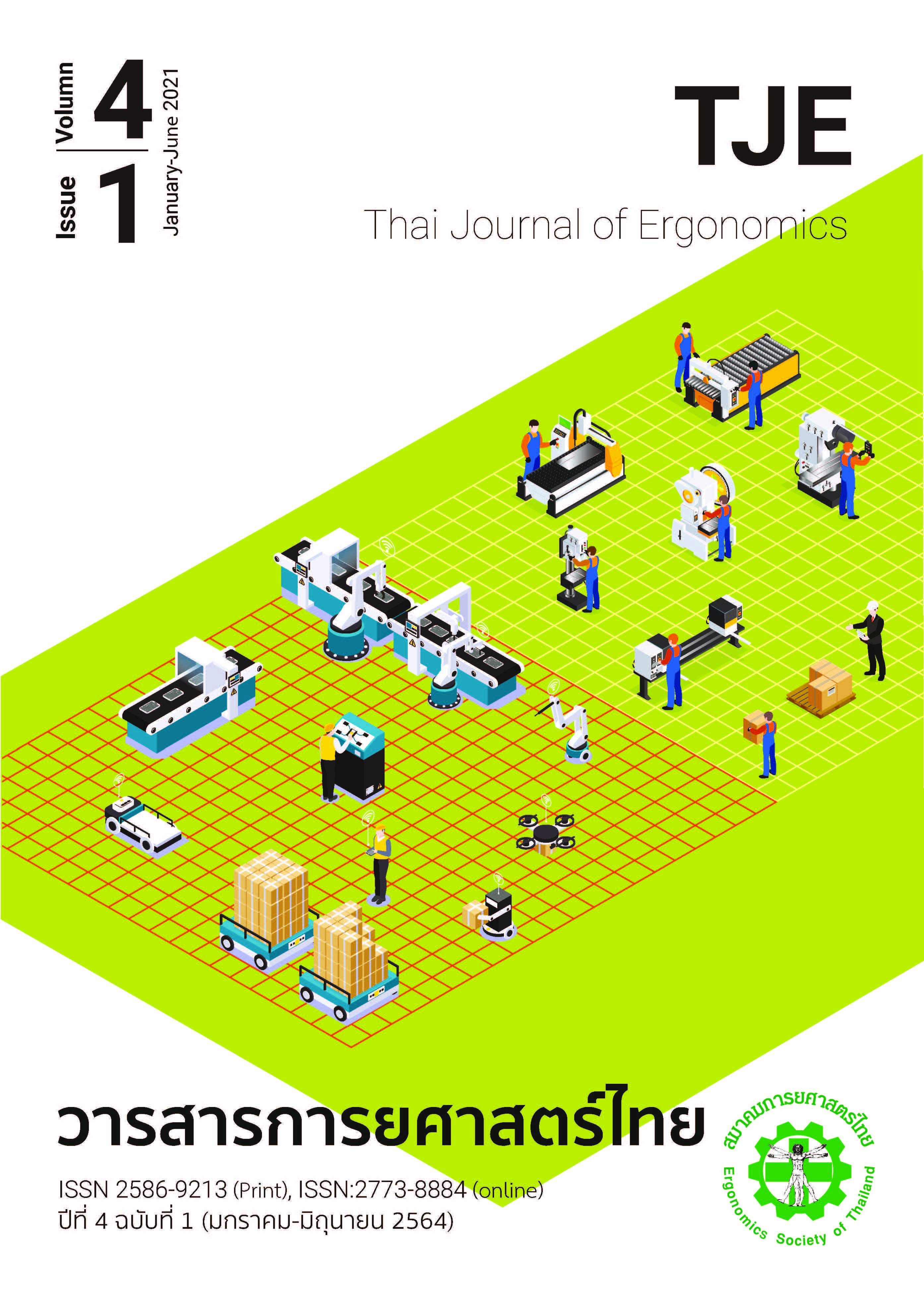A study the factor effect of error in semi auto robot arm control by naked eye
Main Article Content
Abstract
ABSTRACT: The objective of this research is to (1) study the factors that affect the error in the visual control of semi-automatic robots. The factors include the control standing distance, control perspective and workpiece characteristics, and (2) study the mental workload from human visual control in pick and place operations. The analysis results show that the most influencing factor for robot handling errors is the workpiece characteristics second to the control distance. The results showed that the triangular workpiece was the most erroneous, efficient operator and highest mental workload. This research was an experimental study using a selective method of recruiting 10 volunteers who chose a sample from members who volunteered to participate willingly. The experimenter had to control the robot according to the conditions and factors and then to assess the mental load with NASA-TLX assessment. The analysis results show that the most influencing factor for robot handling errors is the workpiece characteristics. Followed by the control distance. The results showed that the triangular-shaped workpiece was the most likely to be wrong and the highest mental workload for the operator.
Article Details
References
ภัทรวุธ สุภามา. การออกแบบระบบหุ่นยนต์เดลต้าแบบสามองศาอิสระสำหรับทำงานกำหนด ตำแหน่งหมุดร่วมกับมนุษย์ในเวลาจริง [วิทยานิพนธ์ปริญญาดุษฎีบัณฑิต]. กรุงเทพฯ:จุฬาลงกรณ์มหาวิทยาลัย; 2554.
International Federation of Robotics (IFR). Welcome to the IFR Press Conference 24th September 2020 [Internet]. 2020 [cited 2021 June 25]. Available from: https://ifr.org/downloads/press2018/Presentation_WR_2020.pdf
GualtierI L, Rauch Erwin, Vidoni R. Emerging research fields in safety and ergonomics in industrial collaborative robotics: A systematic literature review. Robot Comput Integr Manuf 2021;67:101998.
Kagermann H, Wahlster W, Helbig J. Recommendations for implementing the strategic initiative Industrie 4.0: Final report of the Industrie 4.0 Working Group. Berlin: Forschungsunion; 2013 [cited 2021 June 25]. Available from: https://www.din.de/blob/76902/e8cac883f42bf28536e7e8165993f1fd/recommendations-for implementing-industry-4-0-data.pdf
ABB [Internet]. 2020 [cited 2021 June 25]. Available from: https://new.abb.com
บุญธรรม ภัทราจารุกุล. หุ่นยนต์อุตสาหกรรม. กรุงเทพฯ: ซีเอ็ดยูเคชั่น; 2556.
กิตติ อินทรานนท์. การยศาสตร์. กรุงเทพฯ: สำนักพิมพ์แห่งจุฬาลงกรณ์มหาวิทยาลัย; 2548.
Memar AH, Esfahani ET. Objective assessment of human workload in physical human-robot cooperation using brain monitoring. ACM Trans Hum-Robot Interact 2019;9(2):1-21.
Santibanez V, Kelly R. A class of nonlinear PID global regulators for robot manipulators. Proceedings. 1998 IEEE International Conference on Robotics and Automation (Cat. No.98CH36146) 1998;4:3601-6.
Liu Y, Zhang B, Fu B, Yang R. Predictive control for robot arm teleoperation. IECON 2013-39th Annual Conference of the IEEE Industrial Electronics Society. 2013:3693-8.
Alavandar S, Nigam MJ. Fuzzy PD+ I control of a six DOF robot manipulator. Industrial Robot 2008;35(2):125-32.
Chaudhary H, Panwar V, Sukavanum N, Prasad R. Fuzzy PD+ I based hybrid force/position control of an industrial robot manipulator. IFAC Proceedings Volumes 2014;47(1):429-36.
Slotine JE, Weiping L. Adaptive manipulator control: A case study. IEEE transactions on automatic control. 1988;33(11): 995-1003.
Chen CL, Lin CJ. A sliding mode control approach to robotic tracking problem. IFAC Proceedings Volumes 2002;35(1):55-9.
Braikia K, Chettouh M, Tondu B, Acco P, Hamerlain M. Improved control strategy of 2-sliding controls applied to a flexible robot arm. Adv Robot 2011;25(11-12):1515-38.
พงศกร รูปใหญ่, เบญจมาศ พนมรัตนรักษ์. การลดระยะผิดพลาดจากการเคลื่อนที่ของหุ่นยนต์แขนกล SEIKO D-TRAN RT3200 โดยใช้การควบคุมแบบทำซ้ำที่ปรับปรุงใหม่. ว. วิชาการพระจอมเกล้าพระนครเหนือ 2561;28(2):299-312.
Arai T, Kato R, Fujita M. Assessment of operator stress induced by robot collaboration in assembly. CIRP annals. 2010;59(1):5-8.
Hall E. The hidden dimension. New York: Garden City;1966.


